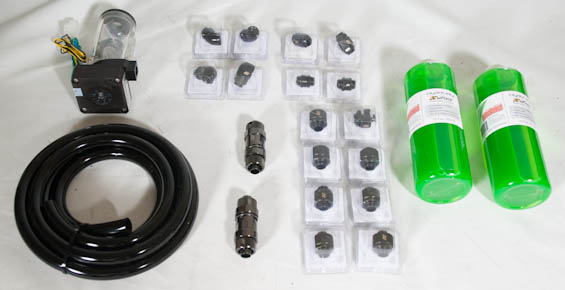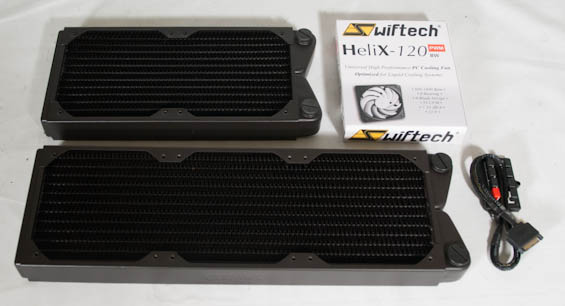The Neophyte's Custom Liquid Cooling Guide: How To, Why To, What To Expect
by Dustin Sklavos on September 30, 2013 12:01 AM ESTWith solid air cooling performance tested, it's time to make the jump to liquid cooling. It's very easy to be intimidated by the hardware involved, but let's break down what Swiftech graciously provided (and they provided quite a bit) and understand what these individual parts represent.

The top left of the photo above is Swiftech's combination MCP35X pump and reservoir, pre-assembled. The MCP35X pump is powered by a 4-pin molex connector, but can run at a variable speed controlled through an additional PWM header. Below it is six feet of very thick black TruFlex PVC tubing. The two large chrome parts to the right of it are no-spill, quick-release couplings designed to be in the middle of the tubing to allow you to disconnect parts of the loop as needed; these use what are called compression fittings. Speaking of which, the bulk of the parts in the surrounding plastic cubes are compression fittings, with 45-degree and 90-degree adapters floating around, along with multi-GPU connectors. Finally, the two bottles are Swiftech's HydrX PM (pre-mixed) coolant.
We're talking about watercooling, so what's in the coolant? Water is actually absolutely excellent at absorbing and carrying heat and has a tremendous heat capacity (think about how long it takes a pot of water to boil); the HydrX PM is actually 90% distilled water (which contains no impurities) and a mixture of chemicals to prevent algae and corrosion. This is very similar to how coolant/anti-freeze works in your car; water carries heat very well, but is also corrosive, so chemicals are introduced into the mixture to counteract that effect.

Next are the radiators. The radiators are made out of copper with brass tubing, and Swiftech carries two different types: one with a normal fin density designed for low speed fans (these), and one with a higher fin density designed for high speed fans. Higher fin density means improved surface area which in turn means superior heat dissipation, but more powerful fans are required to really push air through a denser radiator. For this build, there's one 360mm radiator and one 240mm radiator. Next to them is one of the five Helix-120 PWM-controlled fans intended to be used with the radiators, and the odd-looking dongle is actually a SATA-powered PWM-splitter.










106 Comments
View All Comments
madisoncarter127 - Monday, September 30, 2013 - link
himadisoncarter127 - Monday, September 30, 2013 - link
My last pay check was $11000working 10 hours a week online. My brothers friend has been averaging 17k for months now and she works about 18 hours a week. I can't believe how easy it was once I tried it out.dgingeri - Monday, September 30, 2013 - link
You've sold me on the case, and convinced me to not try water cooling for a while longer, and possibly never. It looks like a lot of hard work for little to no reward. I'll stick to my H100. The case looks great, though.Shinobi_III - Monday, September 30, 2013 - link
If you put the pump in a reservoir, you will no longer have a "noisy" pump.Noisy being a rather absurd wording, considering how incredibly little noise a EHEIM 600l/h pump produces.
That pump you used in the article is ridiculous, what is that, a pump for ants?
And compression fittings are complete suicide, they fail sooner or later.
Perfectly regular ridged slide-over fittings, and a zip tie if you're nervous, will never fail.
And the coolant is ridiculous too, get "long life" automotive coolant, mix it 1:10 and you will never need to worry again. Those bottles are just rebranded, ready-mixed glycol with a giant price tag.
HisDivineOrder - Monday, September 30, 2013 - link
Watercooling GPU's makes sense, but how long before CLC is common on those? It can't be long since everyone's used to CLC's on CPU's where you don't even need water cooling at all. I imagine it won't be long before GPU's too don't need watercooling anymore since they'll be integrated into the CPU.Given that Intel will make its own version of Mantle in short order that they'll pay entire publishers to use, I'm pretty sure we can kiss any advantage discrete cards have goodbye. I'm sure Intel will send AMD a fruit basket for both the idea and making everyone okay with it.
ImSpartacus - Monday, September 30, 2013 - link
Hot damn, this is comprehensive as fuck.Good article!
livingplasma - Monday, September 30, 2013 - link
Thanks for the great article, it's good to see a major tech site like Anandtech cover the often misunderstood art of water cooling. Just skimmed through the comments and a lot of my fellow water cooling guys/gals made some very important points. From my experience it is most important for radiator fan orientation to act as INTAKES. Flipping those top fans to intake can decrease your load temps ~8 degrees celcius from my experience as the way it's currently set up the top 2x120 radiator is using the air from the 3x120 radiator (which is already saturated with heat). Properly decoupled pumps will minimize noise/vibration transmission to the case and with the MCP35X's PMW control it can run very quietly when slowed down 50% which is more than enough flow for most setups. Radiators themselves are low flow resistance, full cover gpu blocks are probably next and CPU blocks tend to have the most but even maxing out a pump only decreases temperatures CPU by a degree or two (plus now the pump is dumping in more heat as well). Removing the stock GPU cooling setups is probably the biggest contributions to water cooling being more quiet than a regular air setup and even with a modest setup the temperature differences are huge as shown with the author's setup.1Angelreloaded - Monday, September 30, 2013 - link
Dustin, Do you know the difference between a Serial and Parallel loop? or how the High flow and Low Flow pressures effect heat dissipation on certain blocks? I understand this may be your first time setting this up; however, in the computer field research is everything, you already know this just like modifying a car without research you end up with an underperforming and underwhelming creation. This is not how a liquid cooled setup should be set up at all, and BTW your Proc temps are higher because the Air source feeding it is already heated from your GPU Rad outlet, try reversing the flow on intake to exit Flow and your CPU temps will be better, CPUs on average run at lower temps on full loads compared to GPUs that can average 70-80 C especially while gaming.hot120 - Tuesday, October 1, 2013 - link
Man, there are quite a few fake 'experts' critiquing this fine article. It seems everyone wants the article done their way. Delid this CPU, change that fan, move this radiator, use that Kill Coil. Enough is enough. It is a basic article on watercolling, and is not meant to cover EVERY SINGLE POSSIBLE configuration. Only the most extreme of the extreme computer users will consider delidding their CPU's. Only the most insane of the extreme computer users will spend $800 on a custom loop to shave 5-10 degrees off their CPU/GPU temps. I'll take my $100 and by a CLC and live happily ever after with my CPU that is +10 degrees (over custom) and my air-cooled GPU. Some of you are tripping!pandemonium - Tuesday, October 1, 2013 - link
Thanks for the introduction article to watercooling. To me - verified according to the results - this says it's still not worth it for a general user and gamer. The cost of increased power, thermals, and noise do not appear to outweigh the performance increase. I know other setups produce better results, but this is a good sample for not bothering with it.Watercooling is still for benchmarking...and that's about it.